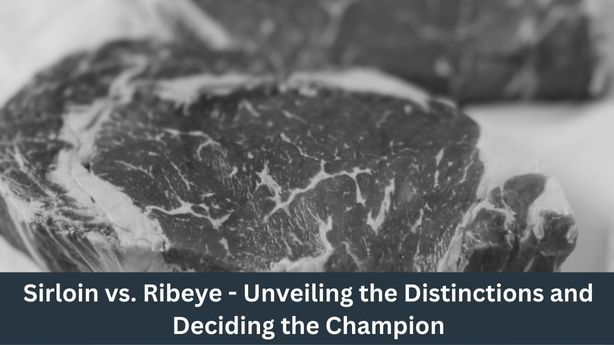When it comes to navigating the meat counter, the choices can often feel overwhelming. Let’s get into the specifics and examine the main variations between two well known beef cuts: sirloin and ribeye.
Understanding Ribeye Steaks
A ribeye steak is derived from the rib section of the cow, specifically ribs nine through eleven. It is known for its marbling, which refers to the beautiful patterns of succulent fat that run through the meat. This marbling not only adds rich flavor but also contributes to the steak’s tenderness when cooked.
Traditionally, the rib bone remains attached to the ribeye, giving it the name “bone-in ribeye.” However, sometimes the bone is removed. Ribeye steaks are highly favored by steak enthusiasts dining out due to their exceptional flavor and texture.
It’s worth noting that the ribeye steak may also be referred to by other names such as Delmonico, Spencer, beauty steak, Scotch filet, or prime rib. The latter term describes the whole roast that results from leaving the ribs intact instead of slicing through them individually.

Exploring Sirloin Steaks
Sirloin steaks can be a bit more complex to understand, as this large cut encompasses several different types of steaks and roasts. Positioned behind the ribs and in front of the rump, the sirloin region gives rise to beloved favorites like T-Bone steaks, strip steaks (such as New York, Kansas City, and Omaha), and club steaks. It also produces roasts like the tri-tip.
Compared to the ribeye, sirloin steaks tend to be leaner and have less marbling. This makes them slightly less tender but still packed with delicious flavor. Top sirloin cuts, including T-Bone and strip steaks, offer a meaty punch and a satisfying chew that delights steak aficionados worldwide.
It’s worth noting that bottom sirloin is not typically sliced into individual steaks. However, it yields flavorful roasts like the tri-tip, which can be slow-roasted to create a hearty meal for a group of diners.
Making the Choice
Determining which cut of beef is better ultimately comes down to personal preference. When considering factors like flavor, texture, and fat content, you can let your own taste and desires guide your decision.
If youre looking for the most intense beefy flavor and a melt in your mouth texture, a ribeye stak is the way to go. Ribeyes also cook relatively quickly, whether on the grill or in a pan, which can be convenient for those short on time. OThe sirloin is a fantastic option if you like a lower fat content, have more time for cooking, or intend to use the meat for dishes like sandwiches or breakfast with eggs.
Additionally, sirloin steaks are typicaly less expensive, allowing you to enjoy a great steak lunch with out breaking the bank.
Dry-aging is a popular technique that enhances the flavor and tenderness of steaks. When a ribeye is dry-aged, it becomes a guaranteed hit, and a dry-aged sirloin can provide all the flavor of a ribeye without the excess fat. So, whether you lean towards ribeye or sirloin, opting for dry-aged versions will offer a delightful culinary experience.
Remember that there is no bad decision in the end. Trust your preferences and savor the unique qualities that each cut brings to the table.
